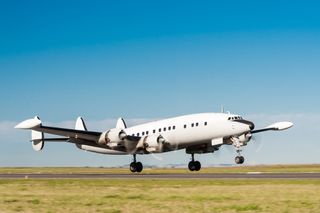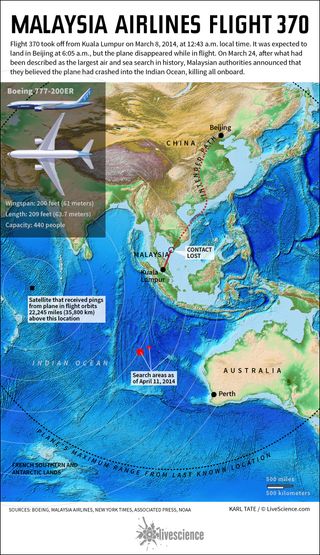Missing Malaysia Flight: 5 Mysterious Airplane Disappearances

Man was not meant to fly, according to the Luddites who witnessed civilization's first fumbling efforts to get an airplane into the sky — and keep it there.
Though aeronautics has made impressive gains since the early days of flight, and airplanes are among the safest ways to travel, the ongoing search for Malaysian Airlines Flight 370 has many people wondering how a large passenger jet could simply disappear.
But disappear, they do — in fact, people and their flying machines have been disappearing into thin air since the 1800s. [Spooky! The Top 10 Unexplained Phenomena]
In 1856, an awning salesman named Matías Perez with an interest in ballooning took off from Havana, Cuba, and was never seen again. At the time, of course, there was no way to track his flight, and it's widely believed that his balloon fell into the ocean. Perez's flight gave rise to the local expression, voló como Matías Perez ("flew away like Matías Perez"), used whenever something inexplicably disappears.

Such events are almost unheard of in aeronautics today: Air traffic controllers track jets using two types of radar. Primary radar determines a plane's position by analyzing signals that bounce back off the aircraft; the secondary, or "enhanced," type requests information from each plane, which is then sent by a piece of equipment aboard a jet known as a transponder.
But even in the era of modern radar, advanced computer systems and satellite technology, disappearances occur. [In Photos: Mysterious Radar Blob Puzzles Meteorologists]
Air France 447
Sign up for the Live Science daily newsletter now
Get the world’s most fascinating discoveries delivered straight to your inbox.
After taking off from Rio de Janeiro in 2009, Air France Flight 447 disappeared from radar screens about three hours later. It took five days for search crews to discover the wreckage of the Airbus A330 in the Atlantic Ocean, and two full years before the flight data recorder was recovered from the bottom of the sea.
It was later determined that the plane — which was flying on autopilot — had crashed after ice crystals formed on the flight instruments, which forced the plane's autopilot equipment to disconnect, eventually causing the plane to stall. All 228 passengers and crew on the flight died.
Three French officials who helped to investigate the crash of Air France 447 are currently working on the Malaysian Airlines Flight 370 disappearance, according to the Sun Daily of Malaysia. The two incidents are often compared to one another, since both disappearances occurred during the modern era of flight on aircraft with a full complement of sophisticated electronic communication equipment. [What Happened to Flight 370? 5 Likeliest Possibilities]
2003 Boeing 727-223
One of the weirder airplane disappearances in recent years occurred in 2003 when a Boeing 727-223 was stolen from an airport in Luanda, Angola. Formerly an American Airlines passenger jet, the plane was leased to an Angolan airline and subsequently grounded for financial reasons.
It's believed by some that an American mechanic named Ben Charles Padilla was on board when the airplane taxied down the runway and took off. Padilla has never been seen or heard from since, and the plane has never been found.
Was Padilla alone when he took off? Did the plane crash into the Atlantic Ocean? Most analysts have concluded that the aircraft's transponder was disabled or missing, making retrieval an unlikely event. Though numerous conspiracy theories exist, the mystery has never been solved.
Uruguayan Air Force Flight 571
In perhaps the most infamous airplane disappearance ever, a 1972 chartered flight carrying 45 people from Uruguay to Chile crashed due to pilot error in a remote spot high in the Andes Mountains. Searchers from three countries looked for the plane, but after eight days, the search was called off.
During that time, the wreck's 27 survivors struggled to remain alive in extreme cold with little food. After an avalanche killed an additional eight people, and with little hope of survival — especially after hearing a radio report that their search had been abandoned — the remaining survivors resorted to cannibalism.
Two people from the crash site, however, were able to trek through the mountains and find help. After 72 days, the last of the wreck's 16 survivors were rescued.
Flying Tiger Line Flight 739
In 1962, a Lockheed L-1049 operated by the flying Tiger Line was transporting U.S. servicemen from California to Vietnam. After refueling at an air base in Guam, the airplane and all 107 passengers disappeared somewhere over the Pacific Ocean.
After an eight-day search involving thousands of people from the U.S. military, the search for the aircraft and any survivors was called off. The crew of a Liberian tanker claimed to have seen a bright light in the sky at roughly the time the flight would have passed over, according to TIME, but the disappearance of the aircraft remains a mystery to this day.
Glenn Miller
Glenn Miller was one of the most celebrated musicians of the 20th century, leading the Glenn Miller Orchestra to international acclaim. And as an enlisted airman during World War II, Miller was charged with rallying the morale of troops overseas.
But before a scheduled appearance at a Christmas concert in Paris, Miller took off from an airstrip in England under heavy fog with his pilot, Lt. Col. Norman Baessell. Miller never arrived at his concert in Paris, leading to numerous theories about his disappearance.
Did Miller's plane crash into the English Channel in bad weather and sink? Was he downed by friendly fire from the Royal Air Force? Or did he actually arrive in Paris, only to die of a heart attack in the arms of a French prostitute? The disappearance is a matter of wild speculation, but the truth may never be known.
Follow Marc Lallanilla on Twitter and Google+. Follow us @livescience, Facebook & Google+. Original article on Live Science.
